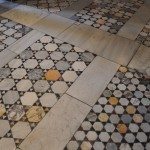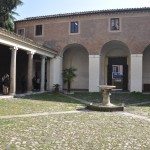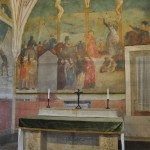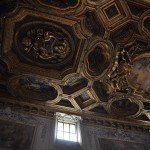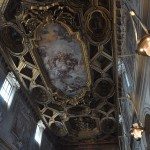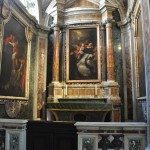Basilica of San Clemente
Basilica of Saint Clement in Rome, Italy is dedicated to Pope Clement I. Saint Clement (92-101 AD) was the third successor to St Peter in Rome.
Basilica of Saint Clement is just a short walk (about three blocks) from the Colosseum. From the outside, this basilica has an Italian Baroque feeling to it.
-
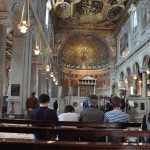
- The most impressive display is the 12th century apse mosaic in a golden bronze color that has a huge crucifix in the middle
The gold gate in the church to the left of altar are incredible. Get real close to them and admire the detail on them. The relics of St. Clement and St. Ignatius of Antioch are beneath the beautiful altar of the church. In the back of the church there is another altar. To the left it contains the relics of St. Servulus. Close by is the 15th-century tomb of Cardinal Venerio. On the other side of the altar is the tomb of Cardinal B. Roverella.
The most impressive display is the 12th century apse mosaic in a golden bronze color that has a huge crucifix in the middle.
The 12th century basilica alone is worth a visit just to see the amazing frescos and mosaics. However Basilica of Saint Clement is particularly notable for its three historical layers. It is a time capsule of Roman life. I had a great time coming here because of the different levels to see. The layers of history are fascinating. Underneath Basilica di San Clemente are the remains of another church dated from the 4th century. This area contains the presumed burial place of St. Cyril as well as surviving frescoes of St. Clement and Sisinnius. Amazingly there is yet another level below that with the remains of a Roman house and Mithraic Temple. One room contains a Mithraic altar. You can still hear, see and touch the water flowing through the basement.
There is a fee to see the ruins (5 euro's), a bargain compared to many other historical sites. On this tour you can see how Rome has been continually built upon itself over thousands of years and how Romans recycled everything.
Phone number: +39 06 774 0021
Monday through Saturday: 9.00 am - 12.30 pm / 3.00 pm - 6.00 pm
Sunday and Holidays: 12.00 pm - 6.00 pm
Address: Via Labicana, 95, 00184 Roma, Italy
There is a nice shop with Christian art that will make a unique souvenir of your visit.






